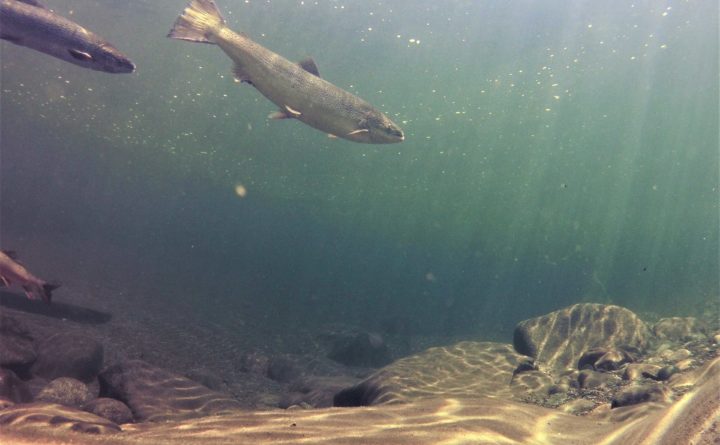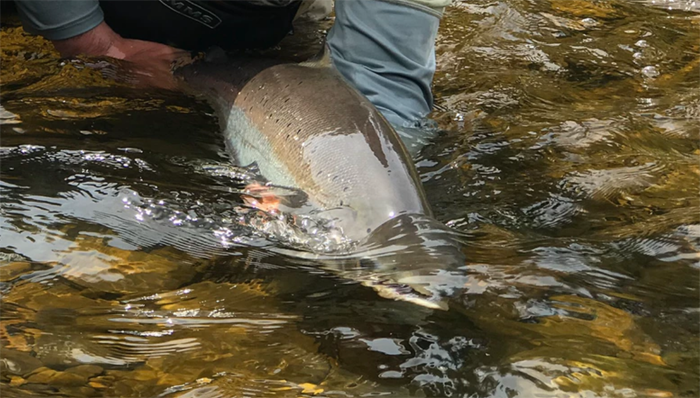
“Charlie” the Atlantic salmon (right) swims among other salmon in a pool of the Sandy River in western Maine. Charlie is a repeat spawner, and was captured twice at Waterville’s Lockwood Dam, exactly two years apart. Casey Clark/Maine Department of Marine Resources.
The ‘mind-boggling’ journeys of one Atlantic salmon
By John Holyoke / Bangor Daily News / July 30, 2019
Your morning commute to work might be hectic and harrowing, but before you start feeling sorry for yourself consider the journeys that Charlie — the name given to a soon-to-be-famous Atlantic salmon — has taken over the past few years.
[dropcap]C[/dropcap]harlie recently was captured in a fish lift at the Lockwood Dam on the Kennebec River in Waterville. That on its own is not a surprise. The fact the adult salmon was actually what’s called a “repeat spawner” and had been captured at the same facility exactly two years (and thousands of miles) earlier was grounds for celebration.
“This is the only repeat spawner we have ever had [in the 13 years since the Lockwood facility has been operational],” said Paul Christman, a marine scientist for the Maine Department of Marine Resources.
Christman said that over the course of a year, all of Maine’s salmon rivers might see one repeat returnee, most of those counted on the state’s busiest salmon river, the Penobscot. This year, more than 1,000 salmon have returned to the Penobscot. Just 56 have been counted at Lockwood. Making Charlie particularly intriguing is the fact he’s either a naturally reared fish from eggs planted by fisheries personnel or a wild-spawned fish.

A Quebec Atlantic salmon – commissioned work. Artist Thom Glace.
And the journeys that Charlie has made are mind-boggling, Christman said:
- According to the U.S. Fish and Wildlife Service, young Atlantic salmon can travel more than 6,000 miles during their migration to and from the North Atlantic, where they will spend between one and three years before returning to their native rivers. That means Charlie might have 12,000 miles on his fins by now. He has surely earned a break, which he is currently taking.
- Charlie was first caught on June 18, 2017, and had a radio tag and a “PIT” tag attached to him. The PIT tag allows scientists to identify him by a unique 16-digit number. The radio tag allowed them to track him until he regurgitated it at some point after he began his return to the Atlantic two years ago.
- In 2017, he was put back in the river below the dam as part of an upstream passage study and was recaptured at the fish lift five days later. Then he was trucked to the upper Sandy River — more than 90 miles away — so he could find a spot to seek female companionship.
- The crew’s radio tracked him to a pair of comfortable pools in the river where he spent the summer.
- Then, after making his way back downriver (and over four hydroelectric dams), he headed back to sea where he flourished for two more years before swimming back to Lockwood Dam on the Kennebec.
- An obliging crew then gave the salmon a ride back to the Sandy, and that’s where he remains, resting comfortably after his second grueling trip in two years.
- “As of last Thursday, he was sitting in one of the pools that he sat in two years ago,” Christman said.

Charlie earns a ride.
Christman said DMR personnel have snorkeled nearby and report that Charlie looks healthy — and big
Jennifer Noll, another DMR fisheries scientist, reported that when Charlie was captured two years ago he was almost 29-inches long. Now, he measures nearly 34-inches from snout to tail.
Christman said many fish die in their natal rivers before even heading to sea once, and they face countless challenges while in the ocean. Upon their return to a river, they must overcome more obstacles and survive predators that would like to enjoy a salmon dinner.
The fact Charlie has made those grueling, life-threatening trips twice makes him a rare fish indeed
“He has defied all the odds. He has actually survived an enormous amount of mortality,” Christman said. “He is at least two years older, three years older than all the other [salmon] in the Sandy River. This guy has seen it all and survived. It really is amazing.”
Christman thinks Charlie successfully spawned two years ago — spawning redds were found near where he was hanging out — and hopes he is able to do the same this year.
Passing along his genetics to future generations can’t hurt, after all
“This guy really wins. I mean, he’s got it all,” Christman said. “It’s really amazing to see a fish that has been through it all and survived [all of those threats]. I just can’t fathom.”
This Atlantic salmon — a repeat spawner — was captured at Lockwood Dam in Waterville recently, exactly two years after it had been previously captured at the fish lift there. It was again trucked to the Sandy River, where a tracking tag indicated that it spawned in 2017. Photo credit – Maine Department of Marine Resources.

Christopher Minkoff releases a bright Atlantic salmon on Causapscal River on June 13, 2019. Photo Jean-Marc LeBlanc / ASF.





